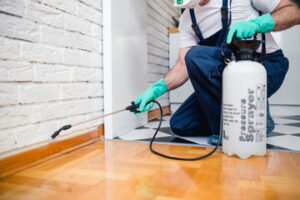Pest control is a process of reducing pest numbers to an acceptable level with as little harm as possible to people, property and the environment. It involves prevention, suppression and eradication.

Eliminate food and water sources that attract pests. Store food in sealed containers and remove garbage on a regular basis. Contact Pest Control Woodland Hills CA for professional help.
Insects are the largest group of animals within the arthropod phylum. They are hexapod invertebrates with a chitinous exoskeleton, three pairs of jointed legs and compound eyes. They are the most diverse group of living organisms, with over a million described species. Insects have a key role in the ecosystems they inhabit as pollinators, decomposers and food sources for other animals and plants. However, they can also pose a serious threat to agriculture, forestry, and human activities as pests in gardens and landscapes or vectors for diseases.
In general, insects have chewing or sucking mouthparts. Some have wings and can fly, while others do not. Insects go through a developmental process known as metamorphosis, in which they go through an egg, larva, pupa and adult phase. Some insects undergo complete metamorphosis, while others, such as cockroaches and mosquitoes, have incomplete metamorphosis and have what is called an adolescence stage in addition to the three major life stages.
Understanding how a specific insect’s lifecycle affects its behavior is important in any pest control strategy. Insecticides, for example, must be applied at the correct time to be effective. Otherwise, they may have little effect on the population or even cause a worse infestation by killing off beneficial insects.
The timing of a treatment also depends on whether it is preventive or curative. Some insects can be prevented by applying a treatment to a soil or plant surface when the pest is not yet an active infestation. For example, a preventive application of a soil drench to stop Japanese beetles from skeletonizing ornamental plants when they are first emerging in June can save many plants.
Other pests require preventive or curative treatments because they cannot be controlled by cultural and other natural means. For example, western flower thrips transmit mycoplasma-like organisms that cause Peach X disease and aster yellows to impatiens grown in greenhouses. A preventive spray of a fungicide can control the thrips and protect the crop.
Rodents
Rodents are common pests that can infest homes and businesses, creating health risks from their droppings, tainted food supplies, and the transmission of diseases from their bites. They also damage crops and other property by chewing through wire, wood and plastics. Fortunately, rodents native to the United States play an important role in maintaining grasslands and forests. The brown rat (Rattus Rattus), for example, provides valuable prey for predators and scavengers. The non-native house rat, on the other hand, is considered a pest because it destroys crops, houses and gardens, and poses serious public health and safety risks.
Rats have a long gestation period and can produce many litters of babies at once. That’s why it is vital to detect a rat infestation as early as possible, advise the pest control experts at Viking Pest. Signs include gnaw marks in and around walls, floors, ceilings and cabinets. The gnaw marks are usually pointed at one end and contain hair. It is also a good idea to look for rodent droppings. The droppings are a dark grey colour and have a distinctive musky odor.
When it comes to proofing your home, you can reduce the risk of a rat invasion by making sure that all entrances are closed and sealed. It is essential that you regularly check and repair all gaps in the siding, roof and foundation of your home. Also, make sure that doors have sweeps that are undamaged and that they close properly. Remove potential nesting sites from the yard, such as piles of wood and debris and ensure that drain inspection covers are in good condition.
A professional pest controller will have monitoring equipment and a range of baits and traps to combat a rat problem. In addition, they will have the expertise to recommend an integrated pest management plan for your property that may involve baits or traps or a combination of both. This will help you to keep rats out without resorting to poison and reduce the number of rats on your property. If you do use rodenticide, it is important to note that a genetic mutation is developing in the rat population that makes them resistant to conventional poisons.
Diseases
Like all living things, plants are susceptible to diseases caused by bacteria, fungi and viruses. These can reduce the rate of plant growth, inhibit reproduction, or even kill them. Insects can also be infected by microorganisms that interfere with their normal function. Infectious microorganisms that attack insects may disrupt their ability to feed, slow their metabolism and interfere with reproduction.
Some microorganisms can directly control disease-causing organisms in plants by competing with them for nutrients, binding to specific receptor sites, or eliciting resistance reactions. Bacteria are the best known examples of such direct controls. For example, the bacterium Agrobacterium radiobacter is used commercially to prevent infection of susceptible plants by the bacterium Agrobacterium tumefaciens, which causes tumorous galls on some crops. Other bacterial controls are directed against particular disease-causing fungi or pathogens. Products based on the bacterium Bacillus thuringiensis, such as Bt sprays, are used to control caterpillars and other pest insect larvae by paralyzing them.
Many of these microorganisms that infect or parasitize insects, fungi and plants also serve as natural enemies of pests. Natural enemies are often more effective than synthetic chemical control agents, and they are usually safer to use in food production systems. However, natural enemies must be able to survive in the field or greenhouse. Many cannot overwinter successfully here in the Northeast, but some can be reared and periodically released in fields or greenhouses.
Biological control of some insect pests can be improved by selective breeding of predators or parasitoids that are more effective against the species being controlled. Intensive cultivation of these “natural” enemies can increase their population density and effectiveness in the field or greenhouse.
Many plant diseases and pathogens have a positive effect on crop health, and some can help suppress pest populations. For instance, some fungi, including the nematode Steinernema carpocapsa, make some plants resistant to certain soil-borne fungal pathogens. Similarly, some nematodes inoculated with bacterial symbionts of plant roots can suppress root-knot nematodes and other pathogens that are harmful to vegetable crops. This approach, called microbial plant protection, is being researched to provide sustainable alternatives to conventional pesticides for the management of plant diseases.
Pesticides
While pesticides are not the only method of protecting crops from disease vectors and weeds, they do play a significant role in making a wide selection of fruits, vegetables and grains available throughout the year. However, pesticides are also dangerous and can affect people in a variety of ways, depending on the type and toxicity of the chemical, the duration and concentration of exposure, and other factors. These effects can range from headaches and nausea to cancers and reproductive harm.
The vast majority of pesticides are ingested or inhaled, but they can also be absorbed through the skin and enter the bloodstream, where they can interfere with enzymes that control vital body functions such as breathing and cell growth. Exposure to pesticides can also cause damage to the liver, kidney and nervous system.
A large number of chemicals are used as pesticides, and they are usually grouped into families based on how they act on the pest that they target. Examples of families include organophosphates, which are designed to attack the nerve-impulse transmissions of insects; insecticidal soaps and fungicides, which suffocate pests by blocking their respiratory processes; and systemic insecticides, which enter plant tissues and kill them from within (see “References”).
Many of these pesticides are toxic to non-target organisms as well. The herbicides 2,4-D, diuron and prometon, for example, can harm non-target plants such as lupins and alfalfa; the fungicides metsulfuron and imidacloprid can kill the mycophagous bugs that feed on fungi; and the insecticidal soaps can kill the tephritid beetles and other parasitic wasps that control the nematode populations that destroy the seeds of some fruit trees.
In addition, the presence of many of these chemicals in the environment can harm wildlife, including birds, bees and butterflies that are critical to crop pollination. The chemicals can also sterilize soil, killing microorganisms that are important for its health and fertility. These negative environmental impacts often result from the inappropriate use of pesticides, and they are an essential reason why provincial and territorial governments are responsible for registering, testing, licensing and training pesticide applicators, vendors and growers, as well as responding to spills and incidents and overseeing the inspection of farms.
